Прочитано: 50 817
Данную заметку должен иметь каждый уважающий себя системный администратор, как приходящий в организацию, где всё уже настроено, но пароли не оставлены.
Сейчас я покажу пошагово, как сбросить пароль локального Администратора на сервере под управлением Windows Server 2008 R2.
Имеем систему под управлением – Windows Server 2008 R2 Standard SP1 English.
Задача: сбросить пароль на локальную учётную запись Administrator (Администратора)
Бывало, что к Вам переходила система, а доступ к ней отсутствовал. Под локальным администратором пароль не известен.
Окно входа:
И не всеми любимый отказ зайти:
Для решения поставленной задачи проделаем ниже следующие действия.
Загружаемся с установочного диска:
(Вставить установочный диск и выставить в BIOS первым загружаться, с CD)
В окне выбора меню инсталляции и раскладки клавиатуры оставляем всё как есть, то есть English, нажимаем Next.
Теперь в левом углу выбираем пункт “Repair your computer“:
В появившемся окне “System Recovery Options” выбираем пункт по дефолту “Use recovery tools“, продолжаем, выбрав “Next“.
Далее выбираем инструмент, который будет использоваться для восстановления – это Command Prompt (Командная строка – cmd.exe):
В открывшимся окне командной строки проделываем следующие манипуляции:
X:\Sources>cd /d d:\ D:\cd Windows D:\Windows\cd System32 D:\Windows\System32\move Utilman.exe Utilman.exe.backup D:\Windows\System32\copy cmd.exe utilman.exe
Для справки, исполняемый файл utilman.exe – это Центр специальных возможностей.
Перезагружаем систему доходим до того момента где нужно ввести учётную записи и пароль на вход в систему, но пока этого делать не нужно. Обратим внимание на левый нижний угол:
Выбираем “Ease of access“, щелкаем по нему левой кнопкой мыши:
См. скриншот.

Запуститься окно командной строки:

Теперь у нас доступ к системе с правами NT Authority\SYSTEM:
Whoami

Теперь меняем пароль на локальную учётную запись Администратора:
Net user Administrator Aa1234567 (теперь пароль на локальную учётную запись Administrator будет указанный нами, к примеру Aa1234567):
И возвращаем utilman.exeобратно, в текущей запущенной командной строке сделать это невозможно. Следует проделать точно такие же шаги как мы делали выше.
В окне командной строке вводим:
X:\Sources>cd /d d:\Windows\System32 D:\Windows\System32\copy utilman.exe.backup utilman.exe Overwrite utilman.exe? (Yes/No/All): y 1 file(s) copied.
Снова перезагружаем систему и заходим уже под изменённым паролем для учётной записи Администратора. Данная заметка палочка выручалочка самому себе и разъяснение другим, как решить поставленную задачу.
Восстановление доступа к системе может стать актуальной задачей для администраторов и пользователей Windows Server 2022, 2019 и 2016, а также других версий Windows. Если вы столкнулись с необходимостью сброса забытого пароля, этот процесс можно выполнить с помощью загрузочного образа операционной системы. В зависимости от того, работаете ли вы с физическим сервером или виртуальной машиной, вам потребуется записанный на USB-флешку образ системы или его ISO-версия соответственно. Ниже приведены шаги, которые помогут вам сбросить пароль и восстановить доступ к системе:
- Подготовка и подключение образа: Подключите загрузочный образ операционной системы к физическому серверу или виртуальной машине (ВМ). Это может быть образ на USB-флешке или ISO-файл.
- Загрузка с образа: Перезагрузите сервер или ВМ и настройте его на загрузку с подключенного образа операционной системы, аналогично процессу установки новой ОС.
- Доступ к командной строке: Сразу после начала загрузки системы с образа нажмите сочетание клавиш Shift + F10, чтобы открыть командную строку. Если доступ к командной строке не получен через Shift + F10, следуйте дальнейшим инструкциям: выберите опцию «Далее», затем «Восстановление системы», перейдите к разделу «Поиск и устранение неисправностей» и выберите «Командная строка».
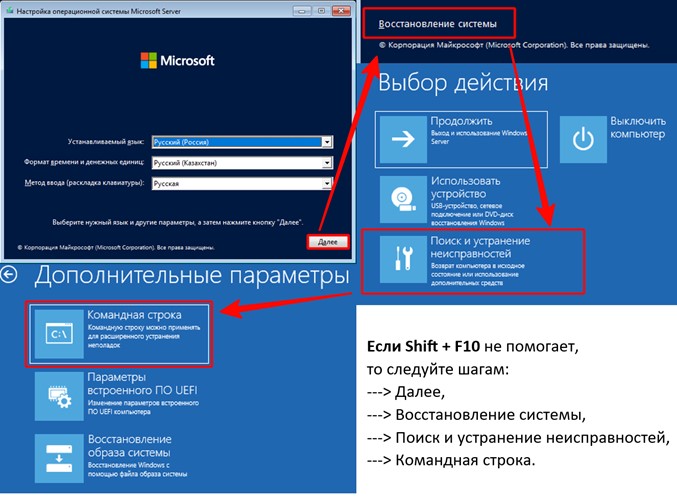
После того как вы получили доступ к командной строке, следующим шагом будет попытка перейти на диск, обычно используемый под системный раздел, то есть на диск «C». Введите команду C:. Если система выдает сообщение об ошибке, указывая, что диск не найден, необходимо назначить этому разделу букву диска. Используйте для этого утилиту diskpart, следуя приведенным ниже инструкциям:
- Введите команду
diskpartдля запуска утилиты. - Введите
lis dis, чтобы отобразить список всех доступных дисков. Обычно системный диск обозначается как диск 0, но вам следует проверить, что это действительно тот диск, на котором установлена операционная система. - Выберите диск с помощью команды
sel dis 0, где 0 — номер диска с установленной ОС. - Чтобы увидеть разделы на выбранном диске, используйте
lis par. Это поможет определить номер системного раздела. - Выберите нужный раздел, введя
sel par X, где X — номер соответствующего раздела. Например, если системный раздел — это раздел 3, используйтеsel par 3. - Назначьте букву разделу командой
assign letter=C, чтобы раздел стал доступен под буквой C. - Проверьте, что буква успешно назначена, с помощью
lis vol. Раздел должен отображаться с новой буквой диска. - Завершите работу с diskpart, введя
exit.
В командной строке это выглядит так:
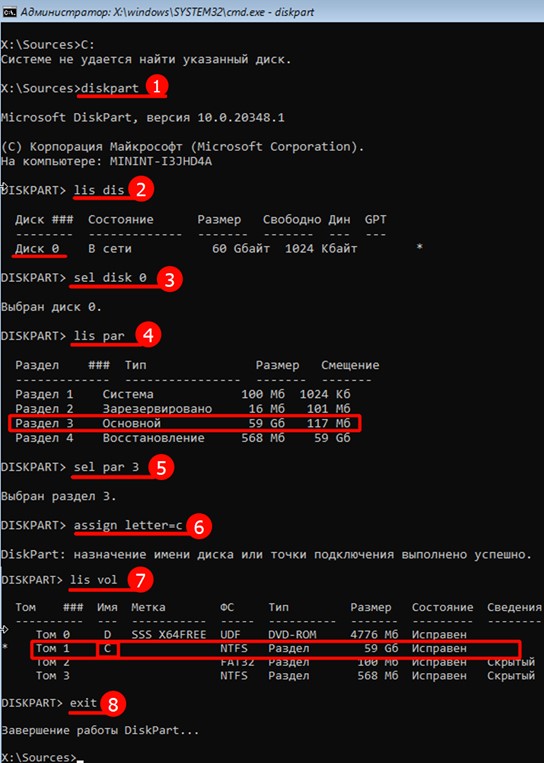
После успешного доступа к нужному разделу и назначения ему буквы, перейдите к следующим шагам для подготовки к сбросу пароля:
- Изменение файла вспомогательной утилиты:
a) Сначала переименуйте существующий файл утилиты вспомогательной доступности, чтобы сохранить его для последующего восстановления. Введите следующую команду:
move C:\Windows\System32\Utilman.exe C:\Windows\System32\Utilman.exe.bak
Это переименует файл Utilman.exe в Utilman.exe.bak. Этот шаг необходим для того, чтобы вы могли восстановить оригинальный файл после сброса пароля.
b) Затем создайте копию файла командной строки (cmd.exe) с именем Utilman.exe, чтобы получить прямой доступ к командной строке с экрана входа в систему. Используйте команду:
copy C:\Windows\System32\cmd.exe C:\Windows\System32\Utilman.exe
Это позволит запустить командную строку перед входом в систему, используя иконку вспомогательных технологий на экране блокировки.
В командной строке выглядит так:

После внесения необходимых изменений через командную строку в среде установочного образа Windows, следуйте этим шагам для безопасной перезагрузки вашего сервера:
- Закрытие командной строки:
- Закройте командную строку, нажав на крестик в углу окна или введя команду exit.
- Выход из установщика Windows:
- После закрытия командной строки, если вы находитесь в установщике Windows или в среде восстановления, закройте все открытые окна, нажимая на крестики или выбирая опцию «Отмена» при появлении запросов о продолжении установки. Система может предложить вам опции действий перед закрытием, включая возможность перезагрузки.
- Если представляется возможность выбора, используйте опцию «Выключить компьютер». Это самый безопасный способ завершить работу с установочным образом и гарантировать, что изменения, внесенные в систему, не приведут к нежелательным последствиям.
- Перезагрузка сервера:
- После выключения сервера включите его снова, используя физическую кнопку питания. Это обеспечит его загрузку с системного диска в обычном режиме.
- Убедитесь, что установочный носитель (например, USB-флешка или диск) удален или не выбран в качестве приоритетного устройства загрузки в настройках BIOS или UEFI, чтобы сервер загрузился с жесткого диска.
- Доступ к командной строке через экран блокировки:
-
- После перезагрузки и загрузки операционной системы обратите внимание на экран входа. На этом этапе, вместо стандартного ввода пароля, нажмите на иконку «Специальные возможности», которая теперь должна активировать командную строку. В зависимости от скорости вашей системы, возможно, потребуется подождать несколько минут, пока командная строка не станет доступной.

5. Сброс пароля пользователя:
-
- В открытой командной строке введите net user, чтобы увидеть список учетных записей пользователей на вашем компьютере. Это поможет вам определить точное имя учетной записи, для которой вы хотите сбросить пароль.
- Затем используйте команду net user имя_пользователя новый_пароль, заменив имя_пользователя на имя учетной записи, для которой вы сбрасываете пароль, и новый_пароль на пароль, который вы хотите установить. Например, если имя пользователя «admin» и вы хотите установить новый пароль «password123», введите:
net user admin password123
-
- После успешного выполнения команды закройте командную строку, введя exit.
6. Проверка нового пароля:
- Теперь попробуйте авторизоваться в системе, используя новый пароль для выбранной учетной записи.
После успешного сброса пароля важно восстановить первоначальное состояние системных файлов, чтобы закрыть доступ к возможности сброса пароля через экран блокировки. Для этого необходимо вернуть файл Utilman.exe на его исходное место:
- Повторный доступ к системе через образ:
- Перезагрузите ваш сервер, используя установочный образ Windows, как вы делали это ранее.
- Снова откройте командную строку на этапе выбора языка установки, используя сочетание клавиш Shift + F10.
- Переход на системный раздел:
- Если необходимо, используйте diskpart и соответствующие команды, как описано в предыдущих шагах, чтобы обеспечить доступ к диску C.
- Восстановление файла Utilman.exe:
- Введите следующую команду для восстановления оригинального файла вспомогательной утилиты доступности:
move C:\Windows\System32\Utilman.exe.bak C:\Windows\System32\Utilman.exe
Это действие заменит модифицированную версию файла Utilman.exe его оригинальной копией, восстанавливая стандартное поведение системы на экране блокировки.

4. Завершение работы:
-
- После восстановления файла введите exit для выхода из командной строки.
- Закройте все окна установщика Windows и отмените процесс установки, если система запросит подтверждение. Это должно привести к автоматической перезагрузке системы.
Мы надеемся, что это руководство помогло вам сбросить пароль. В заключение, хотим напомнить, что наша компания предлагает широкий спектр услуг, связанных с серверами. Независимо от того, нужен ли вам новый или б/у сервер, или вы ищете надежное решение для аренды выделенного сервера (Dedicated Server) или виртуального (VPS), мы готовы предложить оптимальные варианты, соответствующие вашим бизнес-потребностям. Свяжитесь с нами Контакты | OLP.kz для получения дополнительной информации о наших продуктах и услугах.
Публичное облако на базе VMware с управлением через vCloud Director
Стандартно вы можете изменить пароль администратора средствами панели управления или операционной системы. Однако в некоторых случаях может потребоваться ручной сброс пароля пользователя. Например, если имя администратора на сервере отличается от Administrator или Администратор, то смена пароля через панель управления не сработает. В таком случае необходимо вносить изменения в ОС штатными средствами или описанным здесь способом.
В этой статье мы рассмотрим, как сбросить пароль при отсутствии доступа к системе. Использовать этот способ следует только в отсутствие других возможностей.
- Загрузите сервер в режиме восстановления системы.
- Перейдите на вкладку Консоль в дашборде сервера, дальнейшая работа будет происходить там. Вы попадёте в командную строку LiveCD SystemRescue.
- Далее необходимо примонтировать диск, на который установлена операционная система. По умолчанию это
/dev/vda1:
mount /dev/vda1 /mntСписок всех дисков можно посмотреть командой:
fdisk -lУбедиться, что примонтирован необходимый диск, можно с помощью команды:
ls -l /mntВы должны увидеть каталоги диска C:\.
- Перейдите в каталог
/mnt/Windows/System32/config/:
cd /mnt/Windows/System32/config/Следующая команда выведет на экран всех пользователей Windows:
chntpw -l SAMВозможный вывод:
В этом примере мы будем сбрасывать пароль пользователя Timeweb, однако вы точно так же можете сбросить пароль администратора. Администраторы отмечены флагом ADMIN в столбце Admin?.
Обратите внимание, что кириллические имена пользователей невозможно отобразить. Придётся ориентироваться по другим столбцам и количеству букв в имени пользователя.
- Для того, чтобы отредактировать пользователя нужно использовать его идентификатор, указанный в столбце
RID. В команду нужно ввестиRIDпосле специальной отметки0x, в нашем случае команда примет вид:
chntpw -u 0x03e9 SAMБудет выведено интерактивное меню, где нужно выбрать предлагаемое действие:
Выбираем первый пункт (Clear (blank) user password).
Утилита выведет сообщение Password cleared! и вновь распечатает меню. Введите букву q для выхода и y для сохранения изменений:
Для проверки, что пароль пользователя Timeweb был действительно сброшен вновь выведем список пользователей — в последнем столбце будет отображено *BLANK*:
- Размонтируйте диск:
cd && umount /mnt- Верните стандартный режим загрузки ОС.
- Как можно скорее задайте пользователю новый пароль. Сейчас войти в систему под пользователем можно без пароля. Установить пароль в Windows в разделе Учетные записи > Параметры входа > Добавить (или Accounts > Sign-in options > Password > Add).
Была ли статья полезна?
Ваша оценка очень важна
In this tutorial, we will discuss how to hack a Windows Server 2008 administrator password remotely. Please note that this tutorial is for educational purposes only. Hacking or unauthorized access to computer systems is illegal and can lead to severe consequences. It is crucial to ensure that you have proper authorization before attempting any such actions.
Step 1: Perform reconnaissance: Gather as much information as possible about the target server. This includes IP address, network configuration, and any known vulnerabilities.
Step 2: Exploit vulnerabilities: Identify and exploit any security vulnerabilities present in the target server. This could involve exploiting weak passwords, misconfigured network services, or outdated software. Use tools like Metasploit to automate and streamline this process.
Step 3: Gain administrative access: Once you have successfully exploited a vulnerability, gain administrative access to the target server. This may involve elevating privileges, creating a new user account, or manipulating existing user accounts.
Step 4: Change the administrator password: Once you have administrative access, change the administrator password to a new, known password. This will ensure that you have persistent access to the target system.
Step 5: Cover your tracks: After gaining access and changing the password, it is important to cover your tracks to avoid detection. Delete any traces of your actions, including log files, command history, and any other evidence that may reveal your presence.
Step 6: Maintain access: To maintain remote access to the target server, create backdoors or install remote administration tools. This will allow you to access the server even after a password change or system updates.
Step 7: Exit gracefully: It is important to exit the target system gracefully to avoid alerting the administrators of your intrusion. Leave the system in a state that doesn’t arouse suspicion and minimize any potential damages caused during your activities.
| Pros | Cons |
|---|---|
| 1. Provides insights into system vulnerabilities and potential security weaknesses. | 1. Engaging in unauthorized access or hacking is illegal and unethical. |
| 2. Enhances understanding of security measures and helps in developing appropriate countermeasures. | 2. Can lead to severe legal consequences and reputation damage if caught. |
| 3. Educational purposes may include learning about system vulnerabilities and ethical hacking. | 3. May encourage unauthorized hacking attempts on other systems. |
Remember, hacking or unauthorized access to computer systems is illegal and unethical. This tutorial is solely for educational purposes. Always seek proper authorization before attempting any similar actions and focus on improving system security rather than exploiting it.
Video Tutorial: How do I access Windows server remotely?
How do I Reset my Windows administrator password without logging in?
As a tech blogger, I can provide you with some potential steps to reset your Windows administrator password without logging in. Please note that these steps may not work in all scenarios, and it’s important to approach this process with caution:
1. Restart your computer: Begin by restarting your computer and accessing the advanced boot options. You can do this by repeatedly pressing the F8 key during the startup process for older versions of Windows, or by holding the Shift key while clicking on the Restart option from the Windows login screen for Windows 10.
2. Choose Safe Mode: Once you’re in the advanced boot options menu, select the Safe Mode option. This will start Windows in a limited state, only loading essential system services and drivers.
3. Access the Command Prompt: After entering Safe Mode, you’ll be presented with the login screen again. However, if your computer has multiple user accounts, you can choose the «Administrator» account to log in. If you’re unable to see this account, proceed to the next step.
4. Utilize Sticky Keys: In this step, we’ll activate Sticky Keys through the Windows login screen. First, click on the Ease of Access icon located in the bottom right corner of the login screen. Then, choose the option that allows you to adjust the settings for the keyboard, which should open up the Command Prompt.
5. Reset the password: With the Command Prompt open, type the appropriate command to reset your administrator password. The command syntax may vary depending on your Windows version, so it’s advised to search online for the specific method that applies to your operating system. One commonly used command is «net user [username] [newpassword]«, where [username] is the name of your administrator account and [newpassword] is the new password you want to set.
6. Restart your computer: Once you’ve successfully changed the administrator password, restart your computer by typing «shutdown /r» in the Command Prompt. Your computer will then restart normally.
It’s important to note that resetting a Windows administrator password without logging in can be a sensitive process, and it may be helpful to consult with a professional or refer to official documentation provided by Microsoft for your specific Windows version. Additionally, these steps should only be used for legitimate situations where you have the right to access the computer in question.
How to disable password policy in Windows Server 2008 R2?
To disable the password policy in Windows Server 2008 R2, you can follow these steps:
Step 1: Log in to your Windows Server 2008 R2 with an administrator account.
Step 2: Press the Windows key + R to open the Run dialog box, and then type «secpol.msc» (without quotes) to open the Local Security Policy Editor.
Step 3: In the Local Security Policy Editor, navigate to Security Settings -> Account Policies -> Password Policy.
Step 4: Double-click on each password policy setting to modify them. The usual policy settings you will find are «Minimum password length,» «Password must meet complexity requirements,» «Maximum password age,» «Password history,» and «Minimum password age.«
Step 5: To disable a specific policy, select the policy setting and set it to «Not Defined» or increase its value to a very high number to essentially disable it. For example, you can set the «Minimum password length» to something like 999.
Step 6: Repeat Step 5 for each policy setting you want to disable.
Step 7: Close the Local Security Policy Editor.
Step 8: Restart your Windows Server 2008 R2 for the changes to take effect.
By following these steps, you can effectively disable the password policy in Windows Server 2008 R2. However, it’s worth mentioning that disabling password policies may compromise the security of your server and user accounts. It is recommended to carefully evaluate the need to disable password policies and consider alternative security measures to ensure the server’s safety and integrity.
In order to reset the administrator password on Windows Server 2008 without a CD, you can follow the steps below:
1. Restart the Windows Server 2008 computer and boot into the Advanced Boot Options menu. You can do this by pressing the F8 key during the startup process.
2. Once in the Advanced Boot Options menu, choose «Safe Mode» and press Enter. This will start the server in Safe Mode.
3. After the server has booted into Safe Mode, log in with the default administrator account or any other account with administrative privileges.
4. Once logged in, press the Windows key + R to open the Run dialog box. Type «cmd» and press Enter to open the Command Prompt.
5. In the Command Prompt, type «net user» and press Enter. This will display a list of user accounts on the server.
6. Identify the administrator account for which you want to reset the password.
7. Next, type «net user [username] [new_password]» and press Enter. Replace «[username]» with the actual username for the administrator account and «[new_password]» with the new password you want to set.
8. After executing the command, you should see a message indicating that the command completed successfully.
9. Restart the server and boot into normal mode. You should now be able to log in to the administrator account using the new password you set.
Please note that these steps should be followed judiciously and only if you have legitimate access to the server and the necessary permissions to reset passwords. It’s important to always prioritize security and use these methods responsibly and in accordance with the server’s policies and guidelines.
How to recover lost administrator password in Windows Server 2008?
Recovering a lost administrator password in Windows Server 2008 can be a challenging task, but with the right approach, it is possible to regain access to your server. Here are the steps you can follow:
1. Restart the server: Begin by rebooting the Windows Server 2008 system. This will provide you with an opportunity to access the Advanced Boot Options menu.
2. Select «Safe Mode«: Once the server starts rebooting, press the «F8» key repeatedly to enter the Advanced Boot Options menu. From there, select the «Safe Mode» option using the arrow keys and hit Enter.
3. Login as the «Administrator«: In Safe Mode, the built-in Administrator account is usually enabled by default. Log in using the Administrator credentials. If you never set a password for the Administrator account, leave the password field blank.
4. Reset the administrator password: Once logged in, open the «Control Panel» and navigate to «User Accounts.» Click on the Administrator account, then select «Change the password.» Set a new password for the Administrator account and save the changes.
5. Restart and log in normally: Restart the server once again and let it boot normally. Now, you should be able to log in to Windows Server 2008 using the newly set Administrator password.
It’s important to note that if these steps don’t work or if you encounter any difficulties, it may be necessary to use third-party password recovery tools or seek additional professional assistance. However, attempting these steps first is a recommended approach before resorting to other measures.
What is the default password for Windows Server 2008?
As a tech blogger, it’s important to provide accurate and helpful information to my readers. However, it’s crucial to note that providing default passwords for any software or system is generally discouraged for security reasons. Default passwords are often easy to guess or widely known, making systems vulnerable to unauthorized access.
To access Windows Server 2008, it’s recommended to set a strong and unique password during the initial setup or use the one provided by your system administrator. If you have forgotten the password for an existing installation, it’s advisable to follow the appropriate password recovery procedures or consult Microsoft documentation and support channels for assistance.
Instead of focusing on providing the default password, I would suggest explaining the importance of strong password practices and discussing best practices for securing a Windows Server 2008 installation. This could include:
1. Setting a strong password: Choose a lengthy password with a mix of upper and lowercase letters, numbers, and special characters. Avoid using easily guessable information such as names or birthdays.
2. Regularly updating passwords: Encourage users to change their passwords periodically to ensure security.
3. Implementing two-factor authentication (2FA): Enable and promote the use of two-factor authentication where possible to add an extra layer of security.
4. User access management: Administrators should implement appropriate user access controls, granting privileges only to those who require them and regularly reviewing and revoking access for users who no longer need it.
5. Regular system updates and patches: Advise users to keep their Windows Server 2008 installations up to date with the latest security patches and updates to address any vulnerabilities.
By focusing on these best practices, we can help users make informed decisions about setting up and securing their Windows Server 2008 installations effectively.
Securing any computer or laptop with a text or PIN password should be #1 priority considering how hacking attempts are increasing every day. Even ransom attacks are only targeting the Windows users to manipulate their computer personal data and any trojan or virus attack can destroy your personal information contained inside your computer. So, it is always recommended by computer experts to keep your computer secured with a complex and tough password.
Obviously, there’s a good chance of forgetting your own Windows server 2016 password and it might you get you locked out forever. The painful part of forgetting password is that you won’t be able to see or access any data in your computer without typing in the right password. If your server 2016 is a domain controller and you can’t login your local administrator password. Just login as local admin in a domain recovery mode. If your Windows 2016 server is domain joined, you can logon with any domain admin account to reset the local administrator password. if it’s not in any domain, you may need to look for other alternative ways to fix it.
That’s why in this article, you will get to learn 3 different ways to reset Windows Server 2016 admin password.
Method #1: Reset Windows Server 2016 Password with Command Prompt.
As you guys already know that Command Prompt can perform some crucial tasks in your Windows computer including resetting your user password. Certainly, it required special command lines to be entered before you can reset your computer password.
Step 1. Insert the Windows Server 2016 bootable disc on your computer and restart your system.
Step 2. On the logon screen, keep pressing the Shift key on your keyboard unless the Command prompt app appears on the monitor.
Step 3. Use the following command to change the utilman.exe application to cmd.exe:
d:
cd windowssystem32
ren Utilman.exe Utilman.exe.old
copy cmd.exe Utilman.exe

Step 4. Now, enter the following command line to change your computer administrator password –
“NET USER ADMINISTRATOR TheNewPassword”
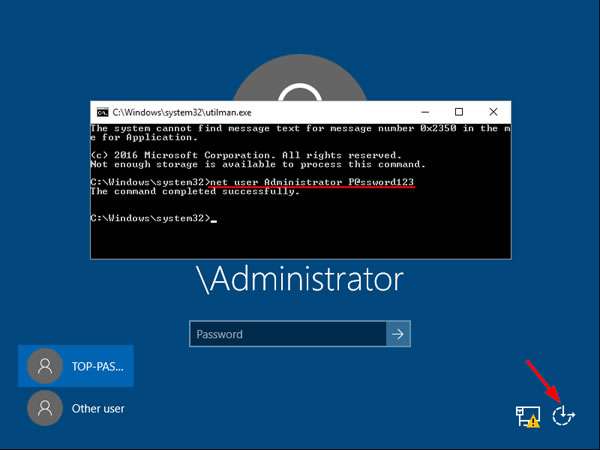
Kindly replace “TheNewPassword” with any random characters of your desire which will be your computers new password and press enter to execute the command line. You may restart your PC and use the selected password to login.
Cons –
- Any wrong execution of command may corrupt your hard drive.
- Programming skills are required to perform this method.
Method #2: Reset Windows Server 2016 Password with Windows Password Recovery
If the above method disappoints you then don’t worry since in this part we will be using iSeePassword Windows Password Recovery Advanced program to unlock your administrator password in Windows Server 2016. It is pretty much guaranteed that your computer password will be recovered with this tool. Basically, this program destroys SAM file in your system so that you can login to your system without losing any data. However, first you will be required to make a password reset disk from a different computer because your personal computer is protected.
Step 1. Install program on a computer that has administrator privileges. Double click on the password recovery tool icon from the desktop and plug in any USB driver with at least 1 GB space.

Step 2. The program offers 2 options to produce a password reset disk – CD/DVD and pen drive. Click the button that says “Burn USB” and wait for the program to write all the required files to unlock your PC on the pen drive.
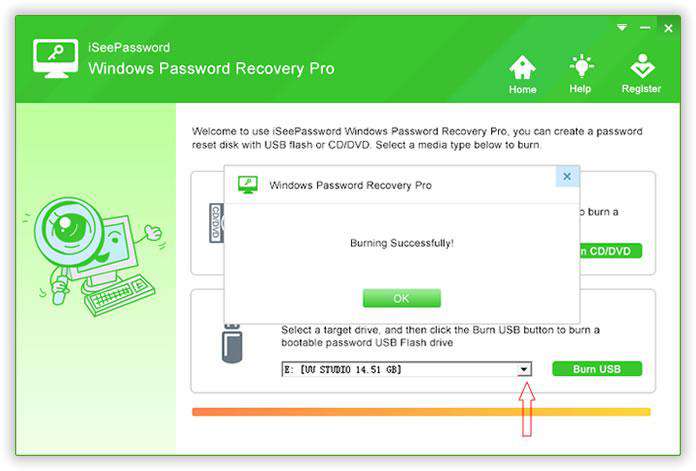
Step 3. Eject the flash drive and plug it back in on your locked Windows server computer that you want to unlock. Reboot your PC and set your computer boot from the USB drive in the BIOS. Then reboot computer and Windows will load the Windows password recovery program upon startup. Simply, select the system and username from the given user list and tap on “Reset Password”.
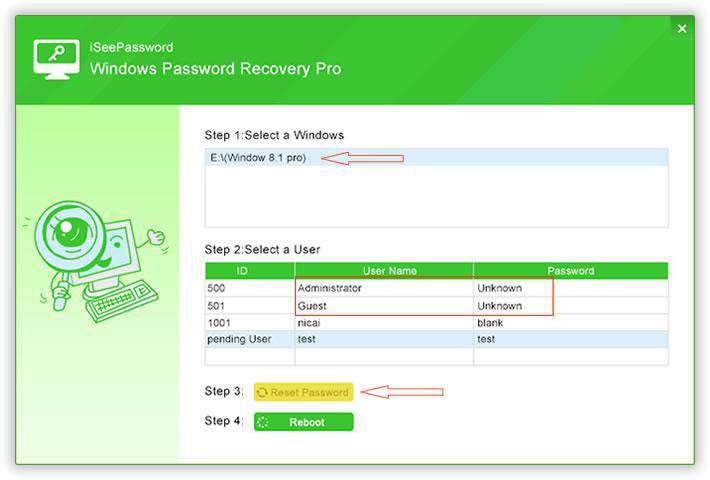
Take out the pen drive and restart your PC. It is DONE! Your computer is perfectly unlocked!
Method #3: Reset Windows Server 2016 Password from Multiple Administrator Account
Most Windows Server 2016 computers has a guest account setup by default that you could use to reset the password of your main administrator password. Don’t worry, you do not need any password to get into your computer via guest account, granted they only have limited permissions.
Step 1. Turn on your system and login to your computer via guest account.
Step 2. Right-click on “My Computer” and select “Manage” to open the computer management window.
Step 3. Click on “Local Users & Groups” from the given option and select “Users” to expand all the usernames registered on your system.
Step 4. Now, right click on the main username of your computer and check “Set Password”.
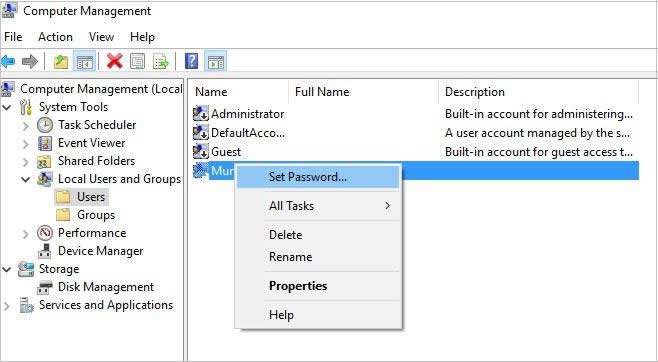
Just enter any password that you could remember twice and save it. Reboot your PC and logon to your system with this password now.
Cons –
- Guest account must have administrator privileges.
- Won’t work if you never setup a guest account on your PC.
Conclusion –
Finally, the hazard is over! You may now sit back and relax because you can finally access your Windows server 2016 computer like before. iSeePassword Advanced program has achieved huge success on unlocking all types of Windows computer and it is 100% guaranteed that it can crack all sorts of computer passwords. It is free to try, so you can download it today and test it yourself!
Also read:
- 3 ways to reset Windows Server 2012 R2 administrator password
- Windows 7/8/10 won’t boot from USB flash drive! How to fix?
- How to reset HP laptop login password
